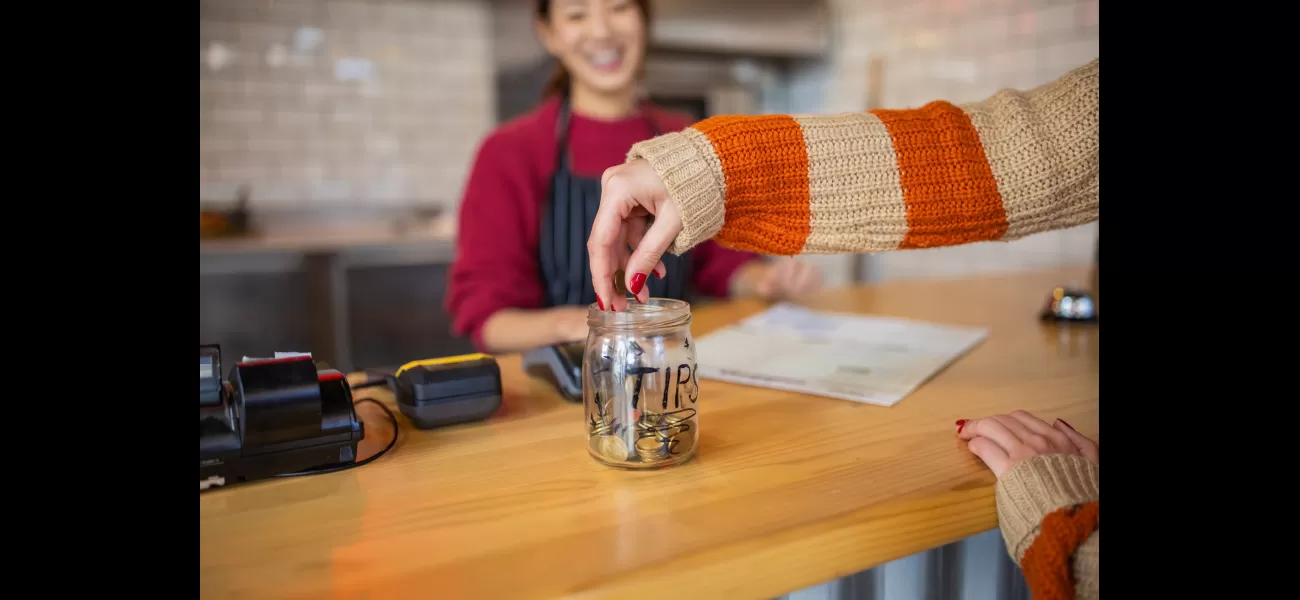Expert advises on proper tipping etiquette while traveling.
Tipping can be seen as rude in certain places.
August 28th 2024.

When it comes to travelling, one of the biggest challenges can be navigating the world of tipping. It's a delicate balance – you want to show appreciation for good service, but you also don't want to offend anyone. It's a minefield out there, and the age-old question of whether to tip or not to tip can leave even the most experienced travelers feeling confused. In the US, tipping is expected for everything from a cup of coffee to a haircut, but the question is, how much is appropriate? And in other countries, the rules can be even more nuanced – with gratuities expected in some places but not in others, and the amount you add to the bill depending on the level of service you receive. To add to the confusion, in some countries, tipping is actually considered disrespectful.
A recent study by Saga Holidays revealed that a whopping 73% of Brits find the topic of international tipping etiquette confusing when on holiday. According to travel money expert Laura Evans-Fisk at eurochange, the average Brit typically tips between 6% and 10% of the total bill if they enjoyed their meal, with an additional 22% tipping between 1% and 5%. However, this can vary greatly depending on where you are in the world, and it's important to do your research before your trip to avoid any awkward situations and ensure that staff are properly compensated for their efforts. As a general rule, it's always better to err on the side of caution when it comes to tipping.
Let's take a look at some of the most popular destinations and their tipping customs. In the USA, tipping is expected and considered almost mandatory. With a staggering 18,000 monthly UK searches for how much to tip in the US, it's no wonder this is the country that causes the most worry for travelers. Laura advises a standard minimum tip of 15% in restaurants, even if you didn't particularly enjoy your meal. For a great meal, you can increase the tip to 18%, and for an excellent meal, 20% is appropriate. When it comes to bars, it's customary to tip the bartender at least $1 per drink, with cocktails typically requiring a higher tip.
In Italy, tipping is seen as a generous gesture rather than an expectation. While gratuities are more of an ad hoc thing, you may see the words "Servizio Incluso" on your bill, which means the tip has already been included and there's no need to leave extra. However, if you see "Coperto" on your receipt, it means the cost of any complementary items like bread or olives has been added to the bill and goes directly to the restaurant, so any leftover tips will be appreciated by the wait staff.
When it comes to tipping, it's important to have the right form of payment. While three quarters of Brits use their card to tip, Laura advises that cash tips are usually preferred by hospitality workers for their immediacy and because card tips often come with deductions. It's also important to check for service charges, which are becoming more common in many places. These charges may be shared by the staff or go directly to the establishment, so it's important to know the customs of the country you're in.
If you're unsure of the tipping customs in a particular country, a good rule of thumb is to always round up the final bill to the largest whole amount. This is a safe option and will ensure you don't offend anyone. And remember, the one exception to tipping etiquette that is almost universally recognized is to tip your tour guides.
In France, tipping is seen as a generous gesture rather than an expectation. The same goes for Spain, where the golden rule is to tip 10% of the bill. In both countries, large tips are considered strange, so it's more common to leave some change or round up the bill. In Portugal, tipping is also seen as a generous gesture, with locals typically leaving around 5% to 10% or rounding up the bill. However, if a service charge is included, there's no need to leave extra.
In Greece, a service charge called "κουβερ" may be added to your bill, but this does not substitute for a tip. It's customary to leave an additional 10% to 15% as a gesture of appreciation. Similarly, in Turkey, it's common to tip between 5% and 10% in restaurants, cafes, and bars, and 10% to 20% at Turkish baths or Hammams for the attendants who provided you with their services.
When it comes to Japan, it's important to note that tipping is actually seen as insulting. It can suggest that the establishment isn't paying its staff well enough or that you don't agree with the price. The best way to show your gratitude is to thank the restaurant or hotel staff, and it's always better to err on the side of caution and not leave a tip.
Lastly, in Canada, tipping is expected and similar to the US. It's customary to tip 15% to 20% for servers in restaurants and $1 per drink for bartenders. However, a goods and services tax is often included on the bill, which can be used as a guide for how much to tip. In Turkey, it's customary to tip between 5% and 10% in restaurants, cafes, and bars, and 10% to 20% at Turkish baths or Hammams for the attendants who provided you with their services.
In conclusion, tipping customs vary greatly from country to country, and it's important to do your research before your trip. It's always better to err on the side of caution and not leave a tip if you're unsure of the customs. However, if you receive good service, it's always appreciated to show your gratitude with a small tip. Happy travels!
A recent study by Saga Holidays revealed that a whopping 73% of Brits find the topic of international tipping etiquette confusing when on holiday. According to travel money expert Laura Evans-Fisk at eurochange, the average Brit typically tips between 6% and 10% of the total bill if they enjoyed their meal, with an additional 22% tipping between 1% and 5%. However, this can vary greatly depending on where you are in the world, and it's important to do your research before your trip to avoid any awkward situations and ensure that staff are properly compensated for their efforts. As a general rule, it's always better to err on the side of caution when it comes to tipping.
Let's take a look at some of the most popular destinations and their tipping customs. In the USA, tipping is expected and considered almost mandatory. With a staggering 18,000 monthly UK searches for how much to tip in the US, it's no wonder this is the country that causes the most worry for travelers. Laura advises a standard minimum tip of 15% in restaurants, even if you didn't particularly enjoy your meal. For a great meal, you can increase the tip to 18%, and for an excellent meal, 20% is appropriate. When it comes to bars, it's customary to tip the bartender at least $1 per drink, with cocktails typically requiring a higher tip.
In Italy, tipping is seen as a generous gesture rather than an expectation. While gratuities are more of an ad hoc thing, you may see the words "Servizio Incluso" on your bill, which means the tip has already been included and there's no need to leave extra. However, if you see "Coperto" on your receipt, it means the cost of any complementary items like bread or olives has been added to the bill and goes directly to the restaurant, so any leftover tips will be appreciated by the wait staff.
When it comes to tipping, it's important to have the right form of payment. While three quarters of Brits use their card to tip, Laura advises that cash tips are usually preferred by hospitality workers for their immediacy and because card tips often come with deductions. It's also important to check for service charges, which are becoming more common in many places. These charges may be shared by the staff or go directly to the establishment, so it's important to know the customs of the country you're in.
If you're unsure of the tipping customs in a particular country, a good rule of thumb is to always round up the final bill to the largest whole amount. This is a safe option and will ensure you don't offend anyone. And remember, the one exception to tipping etiquette that is almost universally recognized is to tip your tour guides.
In France, tipping is seen as a generous gesture rather than an expectation. The same goes for Spain, where the golden rule is to tip 10% of the bill. In both countries, large tips are considered strange, so it's more common to leave some change or round up the bill. In Portugal, tipping is also seen as a generous gesture, with locals typically leaving around 5% to 10% or rounding up the bill. However, if a service charge is included, there's no need to leave extra.
In Greece, a service charge called "κουβερ" may be added to your bill, but this does not substitute for a tip. It's customary to leave an additional 10% to 15% as a gesture of appreciation. Similarly, in Turkey, it's common to tip between 5% and 10% in restaurants, cafes, and bars, and 10% to 20% at Turkish baths or Hammams for the attendants who provided you with their services.
When it comes to Japan, it's important to note that tipping is actually seen as insulting. It can suggest that the establishment isn't paying its staff well enough or that you don't agree with the price. The best way to show your gratitude is to thank the restaurant or hotel staff, and it's always better to err on the side of caution and not leave a tip.
Lastly, in Canada, tipping is expected and similar to the US. It's customary to tip 15% to 20% for servers in restaurants and $1 per drink for bartenders. However, a goods and services tax is often included on the bill, which can be used as a guide for how much to tip. In Turkey, it's customary to tip between 5% and 10% in restaurants, cafes, and bars, and 10% to 20% at Turkish baths or Hammams for the attendants who provided you with their services.
In conclusion, tipping customs vary greatly from country to country, and it's important to do your research before your trip. It's always better to err on the side of caution and not leave a tip if you're unsure of the customs. However, if you receive good service, it's always appreciated to show your gratitude with a small tip. Happy travels!
[This article has been trending online recently and has been generated with AI. Your feed is customized.]
[Generative AI is experimental.]
0
0
Submit Comment





